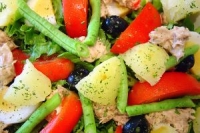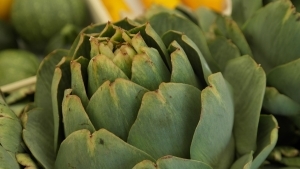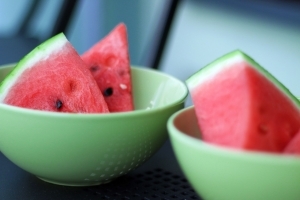Home recipes from Stephanie Alexander
BACK-SPLIT PRAWNS WITH PIQUILLO PEPPERS & PRAWN-HEAD & CHILLI BUTTER SAUCE
serves 4
12 x 12-14 cm long prawns in the shell
1 tablespoon extra-virgin olive oil
12 piquillo peppers or 2 roasted, peeled and sliced red peppers (capsicums)
lemon-infused extra-virgin olive oil, for drizzling
lemon cheeks, to serve
PRAWN-HEAD AND CHILLI BUTTER SAUCE
1 tablespoon extra-virgin olive oil
12 reserved prawn heads
3 garlic cloves, unpeeled and bruised
½ long red chilli, seeded and sliced
3 thick slices lemon
½ cup water
100 g unsalted butter
Pull the heads away from each prawn and reserve for the sauce. The black intestinal tract can be removed and discarded at the same time. Using scissors, cut through the outer shell of each prawn right to the tail. Flick out any intestinal tract not captured when the prawn head was separated from the body. Now with a small sharp knife, butterfly the prawns by slicing lengthways through the prawn meat about half way and pressing open the prawn so that the flesh is evenly exposed and spread in its shell. Do this with all the prawns and then paint the flesh with a little olive oil. Line up the prawns, press them open, then cover with a sheet of baking paper or plastic film and flatten them with a weight, such as a frying pan. Set aside, refrigerated, until it is time to grill them (hopefully no longer than an hour or so). To make the sauce, take a heavy-based, well-seasoned frying pan and heat the olive oil over medium heat. Drop in the prawn heads, garlic, chilli and lemon. Sauté over medium (not high!) heat until the heads turn red. Turn the heads after a few minutes. After about 8-10 minutes, add the water, raise the heat and let the water bubble around the heads. Stir to be sure nothing is sticking. Allow to simmer for a minute or two until most of the water has evaporated, then add the butter. Now keep the heat high until the butter has melted and the small amount of red sauce is bubbling. Strain the sauce through a medium sieve into a jug and set aside. Discard the contents of the sieve. Do not wash the pan! Drop the whole piquillo peppers (or pieces of roasted, peeled peppers) into the unwashed frying pan, and set it aside. Heat the barbecue. Place the prawns on the grill, shell-side to the heat. There is no need to turn them. While the prawns are grilling, gently heat the pan with the peppers to warm them through, or place the pan on the cooler part of the barbecue. The prawns are ready when the flesh is just opaque but still with a suggestion of glassiness. Transfer the cooked prawns to the pan with the peppers and spoon a little of the prawn-head sauce over each prawn. Add the rest of the sauce to the pan and shake to mix. Divide the prawns among serving plates or add to a central serving platter. Drizzle with a little lemon-infused olive oil and serve with lemon cheeks.
NOTES
This dish is a splendid one for a barbecue lunch. All the preparation is out of the way and the grilling will just take a few minutes. But it is not worth doing with small prawns. Choose uncooked prawns in the shell at least 12 cm in length.
**
MELON SALAD WITH CHILLI, WATERCRESS AND CUCUMBER
serves 4
½ teaspoon cumin seeds
½ cantaloupe (rockmelon) or similar melon,
seeded 2 tablespoons fruity extra-virgin olive oil (even lemon-infused)
1 tablespoon lemon juice
½ teaspoon very fine chilli flakes or powder sea salt 8 mint leaves
1 handful young watercress sprigs, washed and dried
1 handful rocket leaves, stalks removed, washed and dried
1 handful tender salad leaves, washed and dried
1 Lebanese cucumber
Toast the cumin seeds in a dry frying pan over medium heat until fragrant. Grind to a coarse powder using a mortar and pestle. Peel the melon, cut it into bite-sized pieces and put them into a bowl. Combine the olive oil, lemon juice, chilli, cumin and a pinch of salt in a small jar and shake, then pour this dressing over the melon. Stir with a large spoon and leave at room temperature for at least 10 minutes and up to 30 minutes. Tear the mint leaves into small pieces. Add the mint and the washed and dried greens to the bowl with the melon. Using a speed peeler with the blade set crossways, shave thin slices from each side of the cucumber until you reach the seeds. Add these shavings to the bowl and discard the seedy core. Now lift all the ingredients either with salad servers or clean hands (the best way, actually) to ensure all the leaves are dressed. Taste a piece of the melon with a leaf. Is it well balanced? It may need a little more oil or a little more lemon. Once you are happy with the balance, divide the salad loosely among plates. I quite like a final scattering of sea salt on top.
DUCK BREASTS GRILLED OVER SALT WITH A SUMMERY PEACH SALAD
serves 4
4 duck breasts, skin on coarse
sea salt
freshly ground black pepper
1 tablespoon extra-virgin olive oil
2 bay leaves, torn into pieces
4 generous thyme sprigs
4 ripe peaches or nectarines
With a sharp knife, score the duck skin deeply in a criss-cross pattern. Do not cut into the meat. Rub the skin with 2 teaspoons salt, some pepper and the olive oil, working the salt deep into the cuts. Scatter the herbs in a non-reactive dish that will take the duck breasts in a single layer. Place the duck breasts, skin-side up, on the herbs making sure each comes in contact with some bay leaf, then refrigerate, uncovered, to dry the skin for at least 30 minutes or even overnight before grilling. Preheat the barbecue to hot and preheat the oven to 120°C (100°C fan-forced) with serving plates in it. Cut the peaches or nectarines into chunky segments, holding the fruit over a plate so you don't lose a drop of juice, then set aside. Keep the plate with the bay leaf and thyme on it on the coolest part of the barbecue to stay warm. Place the duck breasts, skin-side down, on the hottest part of the barbecue. You want a steady sizzle with a bit of flaring. Do not panic if there are flames, and do not keep moving the duck breasts. (If the flames are really dramatic from the first minute, reduce the heat immediately and move the duck breasts to a less hot area and continue to grill.) After 5 minutes, turn the heat down by a third and check the duck by lifting a corner. The skin should be looking deep golden, even a bit scorched, and the flesh side should be just starting to lose its bright-red colour. Grill for a further 3 minutes and then turn the duck breasts flesh-side down to the heat. Give them 2 minutes only on this side. Remove the duck breasts to the plate with the herbs on it, skin-side down, and bring them inside. Tip the peach segments and their juice onto the plate with the duck so that all the juices mingle. Rest the duck breasts in the oven for up to 15 minutes. To serve, move the duck breasts to a chopping board. Keeping them skin-side down, cut the breasts into 5-mm thick slices on an angle and fan them on each warmed plate. Spoon the pieces of peach over the duck and dress with the juices. Grind over a little pepper and add a sprinkle of salt. Follow this rich course with a generous green salad.
***
SALT & PEPPER CALAMARI WITH FRIED LEMON, OREGANO & SAGE
4 calamari (bodies 12-16 cm long)
¼ cup plain flour
¼ cup fine semolina
1 tablespoon dried oregano flowers, as rubbed from a sprig of dried oregano
grapeseed or sunflower oil (plus some extra-virgin olive oil), for deep-frying
½ quantity Coating Batter (see below)
1 lemon, finely sliced 12 sage sprigs sea salt lemon wedges, to serve
Fill the sink with cold water and have a cutting board and knife or scissors handy. Have a bowl ready to take the calamari innards, a plate for the cleaned calamari, and paper towel within reach. Tip the calamari into the sink of water. Take hold of all the tentacles in one hand and pull and twist them firmly - the tentacles will come away with the guts attached. Cut the tentacles just below the ink sac with a knife or scissors. To locate the 'beak' (mouth), take hold of the tentacles and press them away from you. The beak will pop out. Using a knife, cut away the guts, beak and ink sac and drop them into the bowl. Rinse the tentacles in water and set aside on the plate. Locate the cartilaginous shield inside the body and add to the bowl. Discard the contents of the bowl. Rinse the body under running water and strip off and discard the purplish-black or pink membrane. Rinse the body inside and out and add it to the tentacles. Dry the cleaned calamari well with paper towel before slicing as it will be very slippery. Cut the body into fine rings and the tentacles into clusters about 4 cm long. Mix the flour, semolina and dried oregano in a shallow tray. Dip the rings and tentacles into the flour mixture, giving each a good shake to remove any excess, and carefully transfer to a separate tray. The more careful this coating, the better the final dish. You do not want excess flour in the oil. Preheat the oven to 120°C (100°C fan-forced) with a serving plate in it. Line a baking tray with paper towel. Select a heavy-based, deep saucepan for the deepfrying unless you own a temperature-controlled countertop deep-fryer. Pour in oil to a depth of about 6 cm and heat to 170°C. If you don't have a thermometer, a tiny cube of bread should sizzle instantly when the oil is hot enough. Carefully place a few pieces of calamari in the oil (do not drop them in as the oil will splash and burn you), only enough so they sizzle well and are not crowded or stuck together. Fry until golden brown, moving the pieces gently in the oil from time to time with a long-handled wooden spoon, chopstick or brass skimmer. Scoop onto the waiting paper-lined tray for a moment and transfer to the warm plate in the oven. Give the oil a minute or two to recover before adding another batch. When all the calamari is fried, give the batter a stir to be sure it has not settled and dip the lemon slices into it it, allowing any excess to drip back into the bowl. Carefully lower the lemon into the hot oil and fry for a few minutes, moving the slices about as before to ensure both sides are golden brown. Follow with dipped sage sprigs. Serve the fried calamari and lemon slices immediately with a scattering of salt and the lemon wedges.
COATING BATTER
makes about 3 cups
1 cup self-raising flour
1 cup cornflour
400 ml cold sparkling mineral water
Give both flours a quick whisk in a bowl to mix. Slowly whisk in half of the cold mineral water. Whisk in the balance gradually to achieve a smooth, creamy consistency. Use at once or refrigerate and give a quick whisk to reincorporate the flours if there has been settling of the mixture. This batter stores well for 1 day in the refrigerator.












